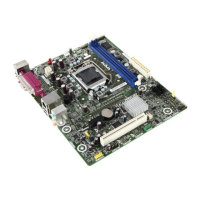Intel Desktop Board DH61SA Technical Product Specification
18
Intel assumes no responsibility that the memory installed on the desktop board, if
used with altered clock frequencies and/or voltages, will be fit for any particular
purpose. Check with the memory manufacturer for warranty terms and additional
details.
Table 3 lists the supported DIMM configurations.
Table 3. Supported Memory Configurations
DIMM
Capacity
Configuration
(Note)
SDRAM
Density
SDRAM Organization
Front-side/Back-side
Number of SDRAM
Devices
512 MB SS 1 Gbit 64 M x16/empty 4
1024 MB SS 1 Gbit 128 M x8/empty 8
1024 MB SS 2 Gbit 128 M x16/empty 4
2048 MB DS 1 Gbit 128 M x8/128 M x8 16
2048 MB SS 2 Gbit 128 M x16/empty 8
4096 MB DS 2 Gbit 256 M x8/256 M x8 16
4096 MB SS 4 Gbit 512 M x8/empty 8
8192 MB DS 4 Gbit 512 M x8/512 M x8 16
Note: “DS” refers to double-sided memory modules (containing two rows of SDRAM) and “SS” refers to
single-sided memory modules (containing one row of SDRAM).
For information about… Refer to:
Tested Memory http://support.intel.com/support/motherboards/desktop/sb/CS-
025414.htm
1.6.1 Memory Configurations
The Intel Core i7, Intel Core i5, Intel Core i3, and Intel Pentium processors support the
following types of memory organization:
• Dual channel (Interleaved) mode. This mode offers the highest throughput for
real world applications. Dual channel mode is enabled when the installed memory
capacities of both DIMM channels are equal. Technology and device width can vary
from one channel to the other but the installed memory capacity for each channel
must be equal. If different speed DIMMs are used between channels, the slowest
memory timing will be used.
• Single channel (Asymmetric) mode. This mode is equivalent to single channel
bandwidth operation for real world applications. This mode is used when only a
single DIMM is installed or the memory capacities are unequal. Technology and
device width can vary from one channel to the other. If different speed DIMMs are
used between channels, the slowest memory timing will be used.
For information about… Refer to:
Memory Configuration examples http://www.intel.com/support/motherboards/desktop/sb/cs-
011965.htm

